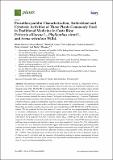Por favor, use este identificador para citar o enlazar a este item:
http://hdl.handle.net/10261/194195COMPARTIR / EXPORTAR:
 SHARE SHARE
 CORE
BASE CORE
BASE
|
|
| Visualizar otros formatos: MARC | Dublin Core | RDF | ORE | MODS | METS | DIDL | DATACITE | |

| Título: | Proanthocyanidin characterization, antioxidant and cytotoxic activities of three plants commonly used in traditional medicine in Costa Rica: Petiveria alliaceae L., Phyllanthus niruri L. and Senna reticulata willd |
Autor: | Navarro-Hoyos, Mirtha; Moreira-González, Ileana; Arnaez-Serrano, Elizabeth; Quesada, Silvia; Azofeifa, Gabriela; Alvarado-Corella, Diego; Monagas Juan, María Josefina CSIC | Palabras clave: | P. alliaceae UPLC P. niruri S. reticulata TQ-ESI-MS Proanthocyanidins |
Fecha de publicación: | 2017 | Editor: | Multidisciplinary Digital Publishing Institute | Citación: | Plants 6(4): 50 (2017) | Resumen: | The phenolic composition of aerial parts from Petiveria alliaceae L., Phyllanthus niruri L. and Senna reticulata Willd., species commonly used in Costa Rica as traditional medicines, was studied using UPLC-ESI-TQ-MS on enriched-phenolic extracts. Comparatively, higher values of total phenolic content (TPC), as measured by the Folin-Ciocalteau method, were observed for P. niruri extracts (328.8 gallic acid equivalents/g) than for S. reticulata (79.30 gallic acid equivalents/g) whereas P. alliaceae extract showed the lowest value (13.45 gallic acid equivalents/g). A total of 20 phenolic acids and proanthocyanidins were identified in the extracts, including hydroxybenzoic acids (benzoic, 4-hydroxybenzoic, gallic, prochatechuic, salicylic, syringic and vanillic acids); hydroxycinnamic acids (caffeic, ferulic, and p-coumaric acids); and flavan-3-ols monomers [(+)-catechin and (−)-epicatechin)]. Regarding proanthocyanidin oligomers, five procyanidin dimers (B1, B2, B3, B4, and B5) and one trimer (T2) are reported for the first time in P. niruri, as well as two propelargonidin dimers in S. reticulata. Additionally, P. niruri showed the highest antioxidant DPPH and ORAC values (IC50 of 6.4 μg/mL and 6.5 mmol TE/g respectively), followed by S. reticulata (IC50 of 72.9 μg/mL and 2.68 mmol TE/g respectively) and P. alliaceae extract (IC50 >1000 μg/mL and 1.32 mmol TE/g respectively). Finally, cytotoxicity and selectivity on gastric AGS and colon SW20 adenocarcinoma cell lines were evaluated and the best values were also found for P. niruri (SI = 2.8), followed by S. reticulata (SI = 2.5). Therefore, these results suggest that extracts containing higher proanthocyanidin content also show higher bioactivities. Significant positive correlation was found between TPC and ORAC (R2 = 0.996) as well as between phenolic content as measured by UPLC-DAD and ORAC (R2 = 0.990). These findings show evidence for the first time of the diversity of phenolic acids in P. alliaceae and S. reticulata, and the presence of proanthocyanidins as minor components in latter species. Of particular relevance is the occurrence of proanthocyanidin oligomers in phenolic extracts from P. niruri and their potential bioactivity. | Descripción: | This article belongs to the Special Issue Medicinal Plants and Natural Product Research. | Versión del editor: | https://doi.org/10.3390/plants6040050 | URI: | http://hdl.handle.net/10261/194195 | DOI: | 10.3390/plants6040050 | E-ISSN: | 2223-7747 |
| Aparece en las colecciones: | (CIAL) Artículos |
Ficheros en este ítem:
| Fichero | Descripción | Tamaño | Formato | |
|---|---|---|---|---|
| reticuwilld.pdf | 790,86 kB | Adobe PDF |  Visualizar/Abrir |
CORE Recommender
PubMed Central
Citations
7
checked on 21-may-2024
SCOPUSTM
Citations
18
checked on 19-may-2024
WEB OF SCIENCETM
Citations
10
checked on 25-feb-2024
Page view(s)
168
checked on 23-may-2024
Download(s)
143
checked on 23-may-2024

